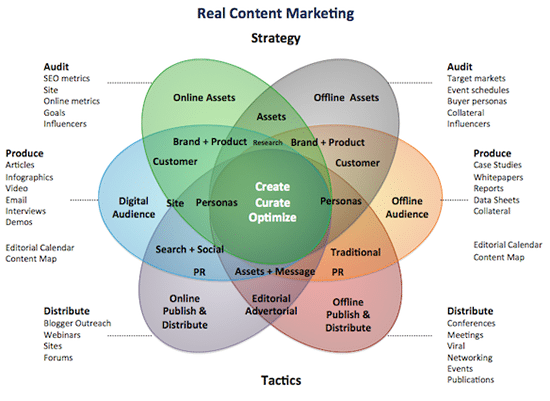In today\’s digital landscape, content marketing has become an indispensable tool for businesses looking to reach and engage their target audience. However, simply creating and publishing content is not enough to drive meaningful results. To truly harness the power of content marketing, it is crucial to develop a well-thought-out strategy that aligns with your business goals and resonates with your audience. This article will guide you through the process of developing a content marketing strategy that drives results.
What is Content Marketing?
Before diving into the specifics of developing a content marketing strategy, let\’s first define what content marketing entails. Content marketing is a strategic approach that involves creating and distributing valuable, relevant, and consistent content to attract and retain a clearly defined audience. The primary goal of content marketing is to drive profitable customer action by providing valuable information and building trust with the audience
.
The Importance of a Content Marketing Strategy
A content marketing strategy serves as a roadmap that outlines the goals, target audience, content creation and distribution plan, and key performance indicators (KPIs) for your content marketing efforts. Without a well-defined strategy in place, your content marketing initiatives may lack direction and fail to deliver the desired results. Here are a few reasons why a content marketing strategy is essential:
1. Alignment with Business Objectives: A well-crafted content marketing strategy ensures that your content efforts are aligned with your overall business objectives. It helps you focus on creating content that supports your business goals and drives measurable outcomes.
2. Targeted Audience Engagement: A strategy allows you to identify and understand your target audience better. This understanding enables you to create content that resonates with their needs, challenges, and preferences, leading to higher engagement and conversions
3. Consistency and Brand Identity: A content marketing strategy ensures consistency in your messaging and helps build a strong brand identity. By defining your brand\’s tone, style, and key messaging pillars, you can create a cohesive content experience for your audience, reinforcing your brand image.
4. Improved ROI: With a strategy in place, you can measure the effectiveness of your content marketing efforts against specific KPIs. This data-driven approach enables you to optimize your strategy, allocate resources effectively, and maximize your return on investment (ROI).
Developing a Content Marketing Strategy
Now that we understand the significance of a content marketing strategy, let\’s explore the steps involved in developing one that drives results.
Step 1: Define Your Goals and Objectives
The first step in crafting an effective content marketing strategy is to define your goals and objectives. What do you aim to achieve through your content marketing efforts? Are you looking to increase brand awareness, generate leads, drive conversions, or establish thought leadership? Clearly outlining your goals will help you shape your content strategy accordingly.
Step 2: Identify Your Target Audience
To create content that resonates with your audience, you must have a deep understanding of who they are. Take the time to conduct thorough research and develop buyer personas that represent your target audience segments. Identify their pain points, interests, preferences, and the channels they frequent. This information will guide your content creation and distribution decisions.
Step 3: Conduct a Content Audit
Before embarking on creating new content, conduct a content audit to assess the performance of your existing content assets. Identify the gaps and opportunities that exist in your content library. This audit will help you determine what content needs to be created, what can be repurposed, and what should be retired.
Step 4: Develop a Content Plan
Based on your goals, target audience, and content audit findings, develop a comprehensive content plan. This plan should outline the types of content you will create (blogs, videos, infographics, etc.), the topics you will cover, and the channels you will use to distribute your content. Ensure that your content plan aligns with your audience\’s preferences and the platforms they engage with the most.
Step 5: Create Engaging and Valuable Content
When it comes to content marketing, quality trumps quantity. Focus on creating high-quality, valuable content that educates, entertains, or solves your audience\’s problems. Incorporate relevant keywords naturally into your content to improve its discoverability by search engines. Additionally, make use of multimedia elements such as images, videos, and infographics to enhance the visual appeal of your content.
Step 6: Optimize for SEO
To maximize the reach and visibility of your content, it is essential to optimize it for search engines. Conduct keyword research to identify relevant keywords and incorporate them into your content\’s titles, headings, meta descriptions, and body. Create descriptive and keyword-rich alt tags for images and ensure that your content follows best practices for on-page SEO.
Step 7: Distribute and Promote Your Content
Creating great content is only half the battle; you also need to ensure that it reaches your target audience. Develop a robust distribution and promotion strategy to amplify the reach of your content. Leverage social media platforms, email marketing, influencer collaborations, and other channels to distribute and promote your content effectively.
Step 8: Measure, Analyze, and Optimize
Regularly track and analyze the performance of your content marketing efforts against your defined KPIs. Utilize web analytics tools to gain insights into metrics such as website traffic, engagement, conversion rates, and social shares. Use this data to identify what is working well and what needs improvement. Continuously optimize your strategy based on these insights to drive better results.
FAQs (Frequently Asked Questions)
Q: How long does it take to see results from a content marketing strategy?
A: The time it takes to see results from a content marketing strategy can vary depending on various factors such as your industry, competition, target audience, and the consistency and quality of your content. Generally, it takes several months to start seeing significant results. Patience and consistency are key to success in content marketing.
Q: What types of content work best for content marketing?
A: Different types of content can be effective in content marketing, including blog posts, videos, podcasts, infographics, case studies, and whitepapers. The choice of content type should be based on your target audience\’s preferences, the complexity of your message, and the platforms you plan to distribute your content on.
Q: How often should I create and publish content?
A: Consistency is crucial in content marketing. Aim to create and publish content on a regular basis, whether it\’s weekly, bi-weekly, or monthly. The frequency depends on your resources and the capacity to consistently deliver high-quality content. Remember, quality is more important than quantity.
Q: Should I focus on evergreen or trending content?
A: A mix of evergreen and trending content is ideal for a well-rounded content marketing strategy. Evergreen content provides long-term value and remains relevant over time, while trending content allows you to capitalize on current topics and capture immediate attention. Striking a balance between the two ensures a steady stream of traffic and engagement.
Q: How can I measure the success of my content marketing strategy?
A: The success of your content marketing strategy can be measured through various metrics, including website traffic, engagement (such as social shares, comments, and time spent on page), lead generation, conversions, and customer retention. Set specific goals and track these metrics regularly to evaluate the effectiveness of your strategy.
Q: Can I outsource content creation for my content marketing strategy?
A: Yes, outsourcing content creation is a common practice among businesses. You can collaborate with freelance writers, content agencies, or subject matter experts to create high-quality content that aligns with your strategy. Ensure clear communication, provide detailed briefs, and review the content before publishing to maintain quality and consistency.
Conclusion
Developing a content marketing strategy that drives results requires careful planning, research, and execution. By defining your goals, understanding your target audience, conducting a content audit, and creating a comprehensive content plan, you can lay the foundation for a successful strategy. Remember to focus on creating valuable and engaging content, optimize it for SEO, and promote it through various channels to maximize its reach. Regularly measure and analyze your results, and make necessary adjustments to optimize your strategy and achieve better outcomes.
Ad2brand Marketing Agency is a trusted partner that can assist you in developing and implementing a content marketing strategy tailored to your business needs. Their expertise and experience in content marketing can help you drive meaningful results and achieve your marketing objectives. Contact Ad2brand Marketing Agency today to elevate your content marketing efforts and make a lasting impact on your target audience.




